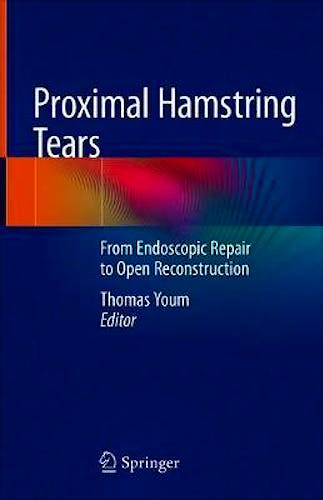

No hay productos en el carrito



Proximal Hamstring Tears. From Endoscopic Repair to Open Reconstruction
Youm, T.
1ª Edición Octubre 2020
Inglés
Tapa dura
157 pags
400 gr
16 x 24 x 1 cm
ISBN 9783030560249
Editorial SPRINGER
LIBRO IMPRESO
-5%
103,99 €98,79 €IVA incluido
99,99 €94,99 €IVA no incluido
Recíbelo en un plazo de
2 - 3 semanas
LIBRO ELECTRÓNICO
-5%
93,59 €88,91 €IVA incluido
89,99 €85,49 €IVA no incluido
Acceso On Line
Inmediato
Preface
Dedication
Chapter 1: Functional Anatomy of the Hamstrings
Chapter 2: Epidemiology, Biomechanics and Classification of Proximal Hamstring Injuries
Chapter 3: Non-operative Treatment of Proximal Hamstring Tendon Tears
Chapter 4: Surgical Treatment of Partial Proximal Hamstring Tendon Tears
Chapter 5: Surgical Treatment of Acute Proximal Hamstring Tendon Tears
Chapter 6: Surgical Treatment of Chronic Proximal Hamstring Tendon Tears
Chapter 7: Endoscopic Treatment of Proximal Hamstring Tendon Tears
Chapter 8: Open vs. Endoscopic Approaches to Proximal Hamstring Tendon Tears: Techniques, Pearls and Pitfalls
Chapter 9: Surgical Complications of Proximal Hamstring Tendon Tears
Chapter 10: Biological Treatment of Proximal Hamstring Tendon Tears
Chapter 11: Rehabilitation after Surgery for Proximal Hamstring Tendon Tears
Chapter 12: Proximal Hamstring Injury Rehabilitation and Injury Prevention
Currently, there are no texts focused on proximal hamstring pathology and surgical treatment options. While midsubstance muscle tears of the hamstring are typically treated non-operatively, proximal hamstring tears often require surgery, which can create anxiety for the orthopedic surgeon, as the exposure is deep and the sciatic nerve is at risk for injury. Moreover, the algorithm for repairing proximal hamstring tears is complex, as the spectrum of pathology starts from partial tears to acute tears to chronic tears with varying degrees of retraction. With the advent of arthroscopic procedures around the hip, innovative treatment methods such as endoscopic surgery have been utilized to repair the proximal hamstring. For successful treatment of chronic hamstring tendon tears, allograft reconstruction has been shown to be successful.
The book opens with a thorough review of the relevant functional anatomy of the hamstring and related structures, before moving on to discuss epidemiology, classification and biomechanics of injury. The main focus, however, is on treatment strategies, from non-operative methods, including cutting-edge biologics, to open, endoscopic and arthroscopic approaches for partial, acute and chronic tears. The management of complications and rehabilitation protocols round out the presentation. Detailed illustrative case examples provide real-world demonstration of each chapter's concepts.
Practical and user-friendly, Proximal Hamstring Tears will be very useful for the sports medicine, orthopedic surgery, rehabilitation medicine, and physical therapy communities.
Thomas Youm, MD, FACS, Clinical Assistant Professor, Director of Hip Arthroscopy, Department of Orthopedic Surgery, NYU Langone Orthopedic Hospital, New York, NY, USA
© 2026 Axón Librería S.L.
2.149.0